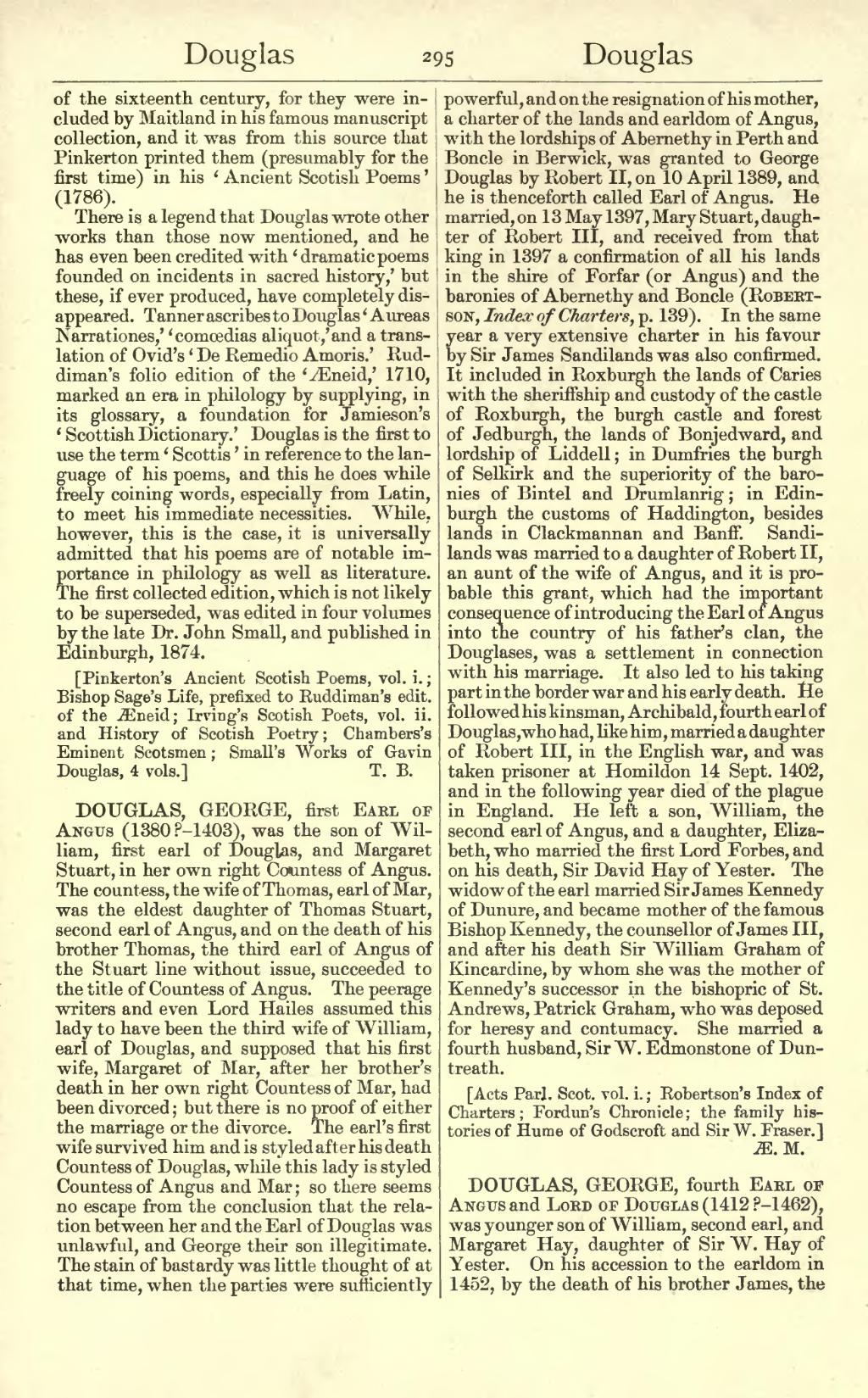of the sixteenth century, for they were included by Maitland in his famous manuscript collection, and it was from this source that Pinkerton printed them (presumably for the first time) in his ‘Ancient Scottish Poems’ (1786).
There is a legend that Douglas wrote other works than those now mentioned, and he has even been credited with ‘dramatic poems founded on incidents in sacred history,’ but these, if ever produced, have completely disappeared. Tanner ascribes to Douglas ‘Aureas Narrationes,’ ‘comœdias aliquot,’ and a translation of Ovid's ‘De Remedio Amoris.’ Ruddiman's folio edition of the ‘Æneid,’ 1710, marked an era in philology by supplying, in its glossary, a foundation for Jamieson's ‘Scottish Dictionary.’ Douglas is the first to use the term ‘Scottis’ in reference to the language of his poems, and this he does while freely coining words, especially from Latin, to meet his immediate necessities. While, however, this is the case, it is universally admitted that his poems are of notable importance in philology as well as literature. The first collected edition, which is not likely to be superseded, was edited in four volumes by the late Dr. John Small, and published in Edinburgh, 1874.
[Pinkerton's Ancient Scotish Poems, vol. i.; Bishop Sage's Life, prefixed to Ruddiman's edit. of the Æneid; Irving's Scotish Poets, vol. ii. and History of Scotish Poetry; Chambers's Eminent Scotsmen; Small's Works of Gavin Douglas, 4 vols.]
DOUGLAS, GEORGE, first Earl of Angus (1380?–1403), was the son of William, first earl of Douglas, and Margaret Stuart, in her own right Countess of Angus. The countess, the wife of Thomas, earl of Mar, was the eldest daughter of Thomas Stuart, second earl of Angus, and on the death of his brother Thomas, the third earl of Angus of the Stuart line without issue, succeeded to the title of Countess of Angus. The peerage writers and even Lord Hailes assumed this lady to have been the third wife of William, earl of Douglas, and supposed that his first wife, Margaret of Mar, after her brother's death in her own right Countess of Mar, had been divorced; but there is no proof of either the marriage or the divorce. The earl's first wife survived him and is styled after his death Countess of Douglas, while this lady is styled Countess of Angus and Mar; so there seems no escape from the conclusion that the relation between her and the Earl of Douglas was unlawful, and George their son illegitimate. The stain of bastardy was little thought of at that time, when the parties were sufficiently powerful, and on the resignation of his mother, a charter of the lands and earldom of Angus, with the lordships of Abernethy in Perth and Boncle in Berwick, was granted to George Douglas by Robert II, on 10 April 1389, and he is thenceforth called Earl of Angus. He married, on 13 May 1397, Mary Stuart, daughter of Robert III, and received from that king in 1397 a confirmation of all his lands in the shire of Forfar (or Angus) and the baronies of Abernethy and Boncle (Robertson, Index of Charters, p. 139). In the same year a very extensive charter in his favour by Sir James Sandilands was also confirmed. It included in Roxburgh the lands of Caries with the sheriffship and custody of the castle of Roxburgh, the burgh castle and forest of Jedburgh, the lands of Bonjedward, and lordship of Liddell; in Dumfries the burgh of Selkirk and the superiority of the baronies of Bintel and Drumlanrig; in Edinburgh the customs of Haddington, besides lands in Clackmannan and Banff. Sandilands was married to a daughter of Robert II, an aunt of the wife of Angus, and it is probable this grant, which had the important consequence of introducing the Earl of Angus into the country of his father's clan, the Douglases, was a settlement in connection with his marriage. It also led to his taking part in the border war and his early death. He followed his kinsman, Archibald, fourth earl of Douglas, who had, like him, married a daughter of Robert III, in the English war, and was taken prisoner at Homildon 14 Sept. 1402, and in the following year died of the plague in England. He left a son, William, the second earl of Angus, and a daughter, Elizabeth, who married the first Lord Forbes, and on his death, Sir David Hay of Yester. The widow of the earl married Sir James Kennedy of Dunure, and became mother of the famous Bishop Kennedy, the counsellor of James III, and after his death Sir William Graham of Kincardine, by whom she was the mother of Kennedy's successor in the bishopric of St. Andrews, Patrick Graham, who was deposed for heresy and contumacy. She married a fourth husband, Sir W. Edmonstone of Duntreath.
[Acts Parl. Scot. vol. i.; Robertson's Index of Charters; Fordun's Chronicle; the family histories of Hume of Godscroft and Sir W. Fraser.]
DOUGLAS, GEORGE, fourth Earl of Angus and Lord of Douglas (1412?–1462), was younger son of William, second earl, and Margaret Hay, daughter of Sir W. Hay of Yester. On his accession to the earldom in 1452, by the death of his brother James, the
